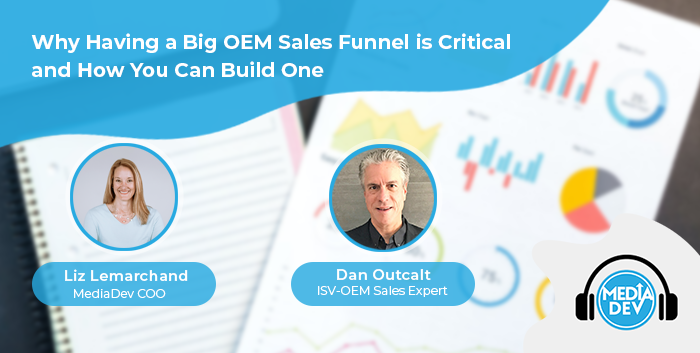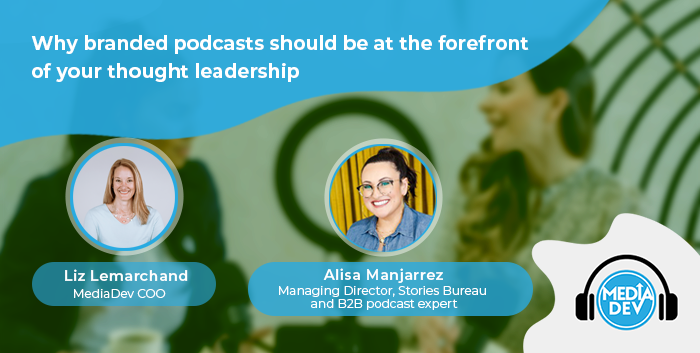In this episode, MediaDev’s COO, Liz Lemarchand, and Accusoft’s Director of Marketing, Tracy Schlabach talk about the value of partnering with another software vendor, the challenges of targeting ISVs, the types of messaging and content that resonate most with ISVs, and tips or strategies on how to talk to ISVs so they will listen. Listen in.
Listen to the episode on Apple Podcast, Google Podcasts, Spotify, Breaker, Pocket casts, RadioPublic, or Anchor, or read the transcript below.
SHOW NOTES
How marketing is different when the outreach is done to software vendors instead of traditional end users [2:58]
The mean value that an ISV can get from partnering with another software vendor [4:29]
Challenges when targeting ISVs [5:57]
How to figure what types of messaging resonate most with ISVs [7:26]
Other types of content that are suitable for nurturing an ISV audience [8: 40]
Tips or strategies on how to talk to ISVs so they will listen [10:29]
If you’ve enjoyed this episode, please subscribe via Apple Podcast | Google Podcasts | Spotify | Anchor to automatically get the next ones!
Thanks for Listening Today!
Share it with someone you believe will also benefit from listening to it. Use the share buttons below! They’ll thank you for it.
TRANSCRIPT
Liz Lemarchand: How is it that innovative software solutions have the ability to change the world yet they don’t sell themselves? How is it that I know my target market but I’m not able to generate enough sales opportunities? How do I even get started to create visibility for my brand when I’m not an expert in marketing? That is the question and this podcast will give you the answer. Welcome to SMplified: Software Marketing Made Simple!
Hey everyone, this is Liz from MediaDev, and today I am joined by Tracy who is the Director of Marketing at Accusoft. Hi Tracy, how are you today?
Tracy Schlabach: I am well and you?
Liz: I’m good, I’m really excited to have this chat with you today about how to talk to ISVs so they will listen. So, in order to get started, I thought it would be nice for our listeners to have some background, and get a little bit of understanding about you, about Accusoft. So maybe you could just start off with giving us a little bit of an introduction.
Tracy: Yeah, happy to. I’m Tracy Schlabach, Director of Marketing at Accusoft. I’ve been with Accusoft coming up on seven years, it’ll be seven years in February. Prior to Accusoft, I worked in computer distribution. I worked for Arrow Electronics and Protect Data. Worked for both of them for seven years in the marketing departments. So kind of cut my teeth in technology and moved from marketing hard goods such as supplies and accessories such as printers, mice, and keyboards, and such and then moved over into software when I worked for tech data. Fell in love with the software side of things and after I left tech data I got brought on to Accusoft. Started out as a product marketing manager and worked my way up to managing the entire marketing department for Accusoft. Accusoft is a manufacturer of APIs and SDKs that developers can integrate into their applications to solve for document lifecycle challenges such as viewing and OCR and redaction, annotation. So that’s a little bit about me and a little bit about Accusoft.
Liz: Excellent, so you’re the perfect person for us to talk to you about this topic, since I know that you often market your products to other software vendors. How do you feel marketing is different when the outreach is done to software vendors instead of traditional end users?
Tracy: When you’re marketing to the types of customers that you’re trying to reach and they’re not end user based, you really have two distinct personas that you’re marketing to. You’ve got the developer persona who is out there testing your product and then you’ve got the problem owner and the decision maker, that are usually one and the same, who is telling that developer ‘hey, we need to solve for this problem, can you go out there and see what’s in the market that we could buy that would help with assisting with this?’ So there’s two very distinct personas that we have to market to in that audience. Whereas with an end user market, you’re really trying to market to the person that has the pain point that they’re trying to solve for, and it’s a very singular, It’s usually a very singular touchpoint, whereas with us, we have two very distinct touchpoints that is, a developer who’s looking at your research and really interested in downloading and testing the product, and then the problem owner who’s also looking at your website trying to figure out ‘do I want my developer to look at this or not’ and then trying to get that engagement with that decision maker or problem owner, so very different from the end user.
Liz: Sure, absolutely. So, what would you say is the mean value that an ISV can get from partnering with another software vendor?
Tracy: Yes, great question. The biggest thing is saving development time. We all know that paying for a team of developers is very expensive. And if you’re looking to build out additional capabilities yourself, you’re either adding a very significant amount of hours to your team’s workload, or you’re having to hire additional developers onto your team to build out that capability, and then support that capability long term. Whereas if you do a third-party integration with a company like Accusoft, you’re saving that development time, one, and then more importantly, you’re not having to keep developers on staff to do all of the updates and the maintenance and the bug fixes. We’re taking care of that for you. So, very significant cost savings and you’re getting the value of us paying about 100 hundred developers to be in the background supporting you and your product needs.
Liz: Sure, so it’s really that buy versus build argument there. So, from your experience, what are some of the challenges that you faced when targeting ISVs? I mean, it seems like it would almost be easier to target an ISV than an end user, but I’m sure you’ve had some challenges as well, so maybe you could go over those a little bit.
Tracy: Most definitely. One of the biggest challenges with the ISV market is that the developers, and even the product owners, don’t necessarily click on our ads. We put advertising out there, they see it but then they don’t necessarily click on and engage with that ad. They’ll just type in the web address to our company. And so the biggest challenge is us having visibility into whether our advertising is working, because a lot of people come in as direct traffic. But you know, and anybody else who is a company that’s marketing to the developer community like I am, they’re going to be sitting there nodding their head because they have the exact same problems. It’s very difficult to know whether your advertising is working, but you do know if you pull advertising away, you see a decline in the number of people coming and visiting your website. So, it’s very challenging to understand if your message is really resonating with the audience.
Liz: That’s very interesting. I wouldn’t have thought of that. So, in as an extension to that, you said that you’re not really sure what messaging works the best. So how then do you figure that out so that you know what types of messaging resonate most with those ISV’s, so that they want to enter into a sales cycle.
Tracy: Yes, so we pay very close attention to the use cases that our prospects are expressing to us. When they raise their hand and they’re wanting to have a conversation with us, we capture the information around what problem are they trying to solve and then we kind of reverse engineer what they probably came and searched for to find us. Then based on that information, we build additional marketing materials to support those particular search terms.
Liz: Sure, yeah that’s right. And of course you can’t have too many use cases, I would say.
Tracy: Oh, not at all. And some of them are very interesting there. I find it very creative how customers and prospects use our products and it’s interesting the ways that they will use our products that we didn’t even think about when we were developing them. It’s kind of exciting to see those opportunities.
Liz: in addition to use cases, what other types of content would you recommend to somebody who is trying to nurture an ISV audience?
Tracy: Giving them valuable information that relates to the problems that your product can solve, one. And then tutorials on how to implement your product and how to use it to solve problems. For example, one thing that we’re doing internally is we are creating videos that are little snippets. They’re about 3 to 5 minutes in length. They show a Use Case and how you can use our product to solve for that use case. So, the more of those that you can build that helps your prospect put themselves in your shoes and understand how your product can be used, the better off it will be. The more of that content that you can create, the more people that you will attract that will go ‘Oh, I see how your product can solve my problem.’
Liz: Yeah, I find that actually that’s one of the best things to do. Since you know, sometimes I find that you know marketing content for ISVs is very vague. It’s not very specific. Sometimes people use kind of generic terms that will help optimize content, the things that are kind of what I call marketing blah blah. They are these nice-sounding phrases, but they don’t really mean very much to anyone in a more specific context. So, I love what you’ve just said about taking the use case and really, making it a video so it’s very visual. Some people love visual content and not just the written word. I love that idea. That’s great.
Liz: So, what other tips or strategies would you like to share with our listeners today?
Tracy: The biggest thing is to get to know your audience. What I mean by that is, you interview your customers and get to know them, talk to them about what was the problem they were trying to solve for, and how did they use your product to solve for it. And then additionally, you know, get out in the field, go talk to the prospects that have come in whether they have bought from you or not bought from you. There’s information that you can glean about what was the use case they were trying to solve for and where did your product fit, or where did it not fit. In all honesty, I think understanding where you didn’t fit is almost as valuable, if not more valuable, to help you better position your product to those folks that have very distinct needs that really match your product. I think there’s value in having those win-loss conversations. Additionally, get out in the field, you know, go to the tradeshows. Talk to people walking by the booth and really get to know what are the pain points they’re trying to solve in their industry. That’s going to give not only insight into how you can help them from a marketing perspective, but then that’s valuable information To pass back to your product team, because maybe there’s a different direction that your product team could take or a slight tweak to your product that the product team could make that would be of value with where the industry is going today.
Liz: I love that. Product marketing teams and the developers obviously need to work really hand in hand on those types of features so that we’re always better serving the customer at the end of the day.
Liz: So excellent, well thank you so much, Tracy. I really appreciate your time today and of course, for all of our listeners you can find other great podcasts at our resource library at mediadev.com. Come and we’ll talk to you again. Tracy, thanks so much.
Tracy: Thanks my pleasure.
Liz: You just listened to SMplified brought to you by MediaDev. If you have software marketing questions or need help marketing your software solution, reach out to us at contact@mediadev.com and check out other amazing assets for you on our resource library at mediadev.com.








